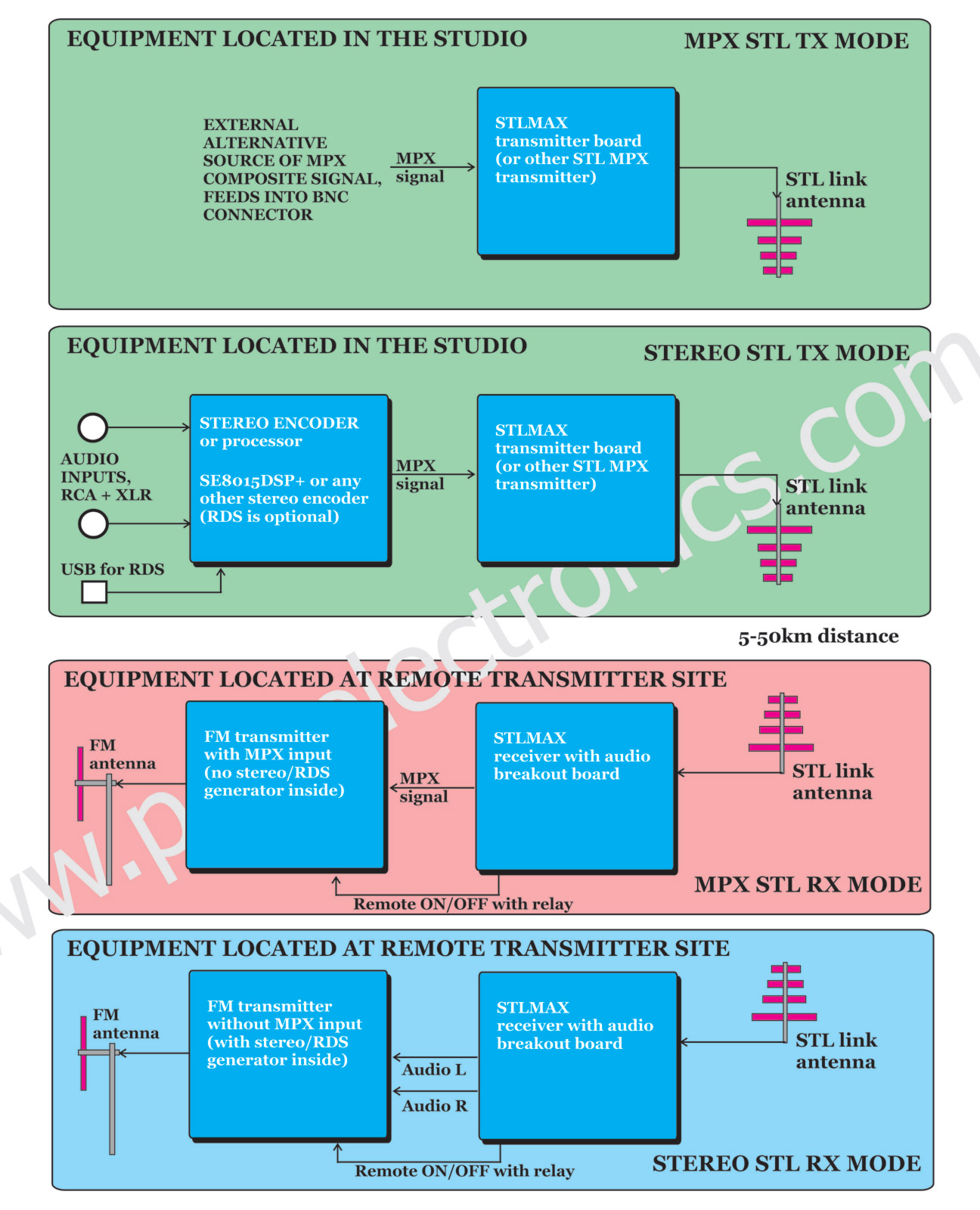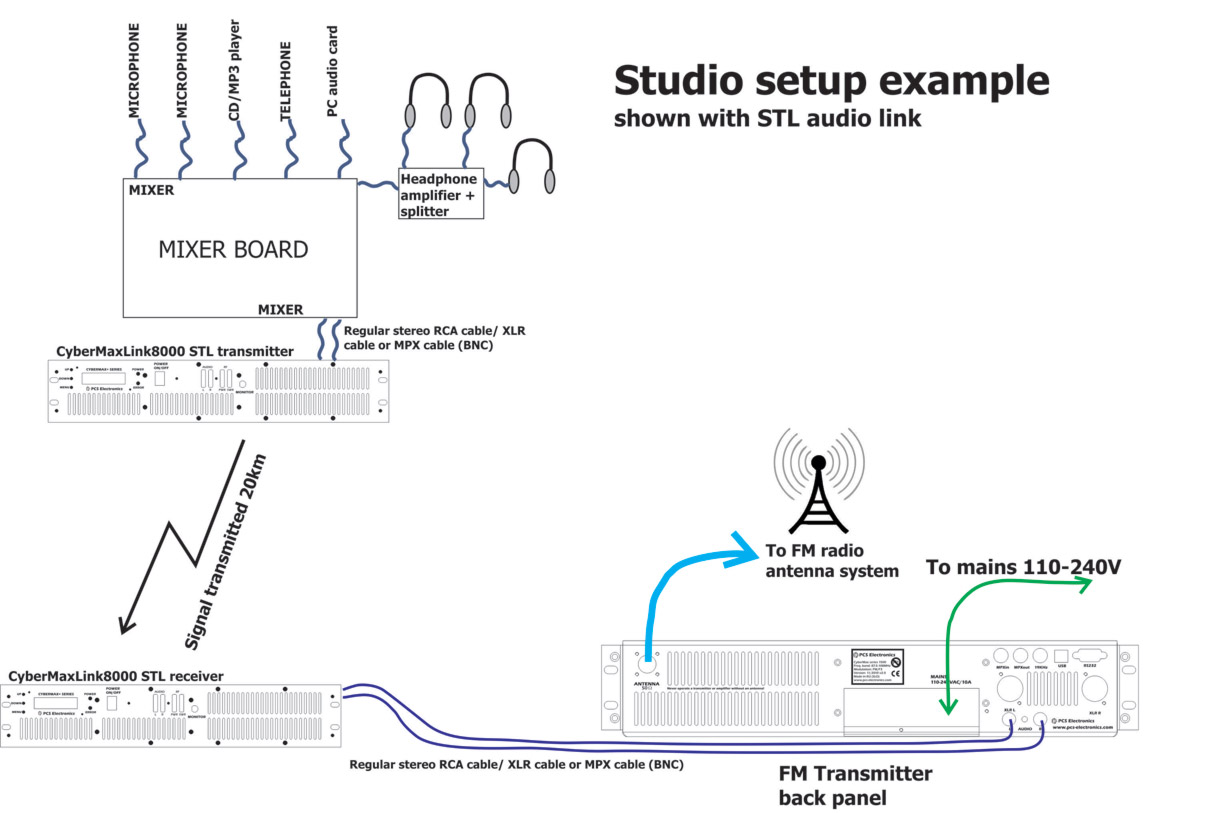Description
Need to send your audio from studio to the remote transmitter and don’t want to break your budget? Now with 10W or 25W of power and covering also UHF band! CyberMaxLink8000+ VHF/UHF Studio to Transmitter audio link is a MPX Stereo wideband FM audio system providing a high quality broadcast audio wireless bridge at accesible prices. These systems offer great value and work either in MPX or two-channel stereo mode and offer excellent overall performance.
Main features:
– Covers frequencies from 45-900MHz (specify 10MHz segment at the time of ordering, at the moment transmitters don’t cover this entire frequency band)
– The transmitted and received frequency can be set by LCD display on front panel (UP/DOWN keys)
– Accesible price
– Suitable for MPX systems (stereo encoder in studio) or for 2-channel systems (2 audio channels, left+right, with 19KHz notch filter to prevent beat frequency)
– Built-in speaker driver for easy monitoring at the receiving side (speaker not included)
– Low THD distortion: the THD value with stereo or mono demodulated and deemphasized signals is negligible
– Flat frequency response
– Excellent signal to noise ratio either in mono or in stereo
– High sensitivity and RF immunity
– High adjacent channel rejection
– High frequency stability
– Integrated LCD Display: complete diagnostic and measurement front panel LCD displays
Technical specifications for transmitter:
– Frequency band covered: 45-500MHz (specify 10MHz segment at the time of ordering)
– PLL step: 100KHz
– Modulation: FM, ±75 KHz peak deviation
– Frequency stability: <±200 Hz
– Output power: 10W or 25W, adjustable from 0 to max via LCD display
– Output impedance: 50 unbalanced, VSWR less than 2:1 for full output
– RF output connector: BNC female (rear panel)
– RF Spurious: >-75 dBc @ +- 1MHz min. away from carrier
– RF Harmonics: > -50-60 dBc Standard
– Monitoring Led: Power on, SWR/TEMP/PLL error
– Audio input connectors: RCA (cinch) and XLR (DSP version)
– Audio level: 1Vpp
– Audio input impedance: 10Kohms
– Pre-emphasis: Flat, 50 or 75usec, adjustable
– Audio channel frequency response: 20 to 15 KHz ± 0.15 dB
– MPX input frequency response: 10 to 100 KHz ± 0.15 dB
– AUX input frequency response: 10 to 100 KHz ± 0.15 dB
– Harmonic distortion (THD): > 0,1% ( 0,05% typ. )
– Channel separation: 40 dB min., 20Hz to 15kHz
– AUX / MPX input level: -10 to +13 dBm @±75 KHz deviation
– AUX channel input impedance: 10K
– Audio input connector: PCB solder and 2-pin jumper
– Power supply: DC 13.8-15V/2A
– Operating ambient temperature range: -15 to 45C (with appropriate cooling)
– Dimensions : 100mm x 125mm x 30 mm (same size as max pro 5000 series FM exciters)
– Weight: 0,4Kg
Technical specifications for receiver:
– Frequency band covered: 45MHz-999MHz (specify 10MHz segment at the time of ordering)
– Built-in speaker amplifier for easy monitoring (speaker not included)
– Sensitivity: ~1uV 10dB SINAD (varies with frequency band, falls rapidly above 600-900MHz, can be corrected with preamplifier)
– Frequency response MPX: 20 Hz to 60 KHz ±0.1 dB
– Stereo separation: 20 Hz to 15 KHz >40 dB
– 19KHz notch attenation: > 60 dB
– S/N Ratio : >65 dB @-40 dBm , 75 KHz dev. and 1 KHz mod.
– THD : 20 Hz to 53 KHz <0.3%
– Selectivity: ±160 KHz at -3 dB IF BW, ±500 KHz at -62 dB IF BW
– Image rejection: >65 dB
– Stereo audio output impedance: 50 ohm balanced
– Stereo audio output connector: RCA/CINCH female
– MPX output impedance: 75R
– MPX output connector: BNC female and XLR balanced
– Headphones output: >2×0.2 W stereo at 32 ohms
– Headphones output connector: 3.5mm stereo phone jack
– RF input impedance: 50ohm
– RF input connector: BNC Type – female
– Power: 12-15V, 1A
– Power consumption: approx 10W
– Operating temperature range: -15 to 50C
– Dimensions : RF board 100x125mm, audio breakout board 100x80mm
– Weight: 0.5Kg
IMPORTANT!
– At the time of ordering please specify 10MHz frequency band, for example 210-220MHz! Units work best at the frequency they are set at in the factory!
– These boards are not for beginners. You may need frequency counter and oscilloscope. Mounting this into metal enclosure can create resonances which may make your unit oscillate or not work properly. It depends on exact type of enclosure (dimensions) and can be unpredictable. Be warned before you buy!
EXPLANATION FOR DSP STEREO/RDS:
– STL transmitter board accepts either mono signal or composite MPX signal which is generated by stereo encoders such as SE8000. You need to order one of these if you don’t have MPX source yourself, otherwise you will be transmitting mono signal. You can also add RDS encoder with IO board (needed to program RDS via PC). This means your STL transmitter now also contains DSP audio stereo processor and RDS encoder (requires SE8000 DSP+ and RDS encoder option).
– If you do not want to use our stereo encoder and have other MPX source or even software for generating stereo signal it is recommended that you use our MPX audio input board which ensures RF immunity, prevents ground loops and offers MPX filtering and limiting.
What is this OCXO signal generator about?
When you want to test a STL receiver or tune a directional antenna you need a reliable, adjustable and frequency agile signal generator. This inexpensive OCXO generator can be set to any frequency from 330KHz to 330MHz. Second and third harmonics can be heard practically up to 1GHz. Manual for this generator is available here. With this generator you can:
– See whether receiver is tuned into correct frequency and working. With this you will see whether your STL transmitter might actually be broken.
– Check signal strength on S-meter, you can now tune input coils for best sensitivity. Use an attenuator or move generator away from receiver for best results
– Tune antennas. Place generator away from your receiver antenna in desired direction with a small wire antenna. Now move antenna to get best signal.
– It is also usable in your lab as a signal source when you can’t find a certain quartz crystal
– Fine tune frequency as these generators are very precise. Tune xtal trimmer in receiver for best signal.
To look for a suitable antenna check: here.
To look for a suitable coaxial cable check: here.
To look for a suitable case for transmitter board check: here.
All our manuals and software are available here.




Reviews
There are no reviews yet.